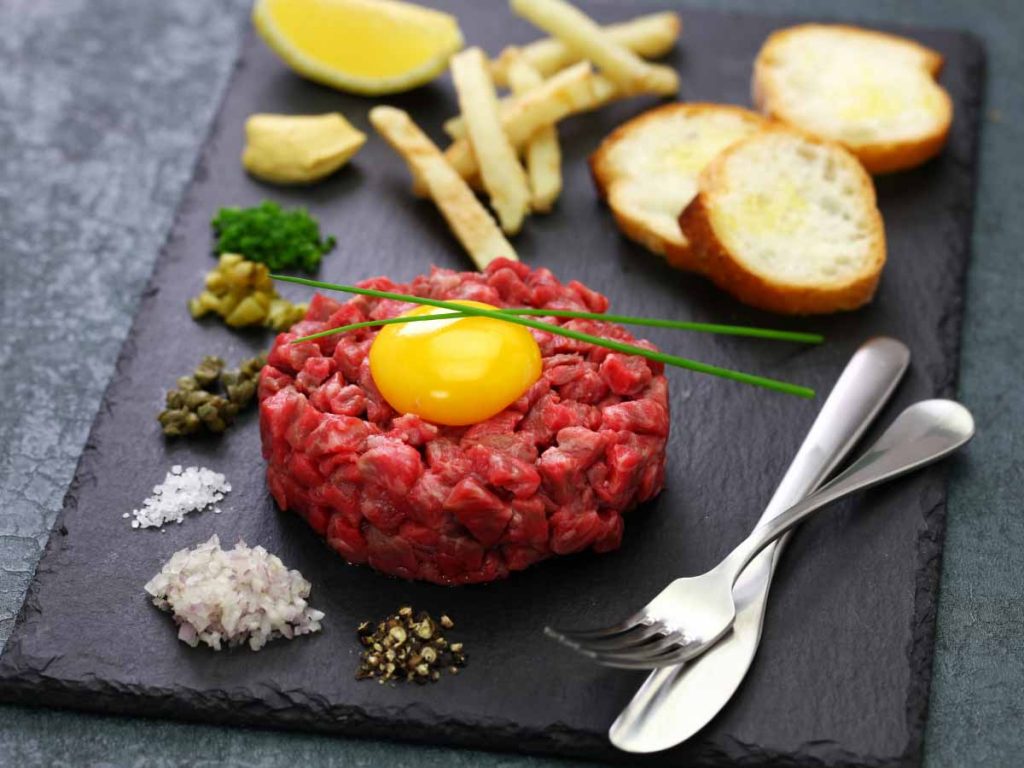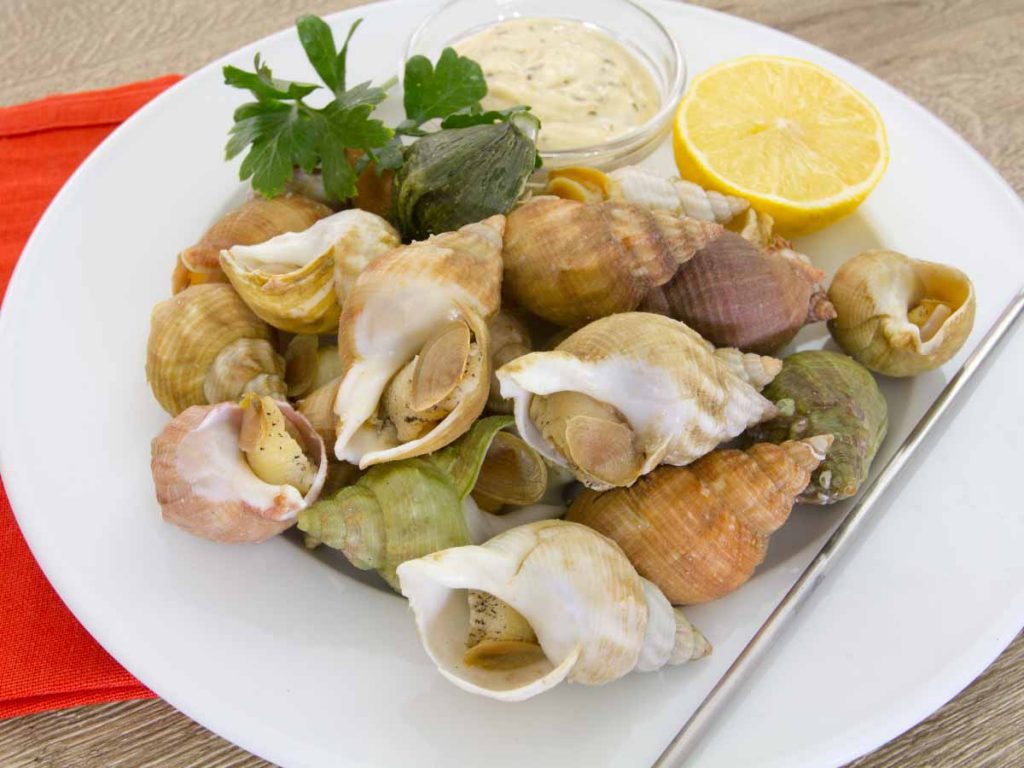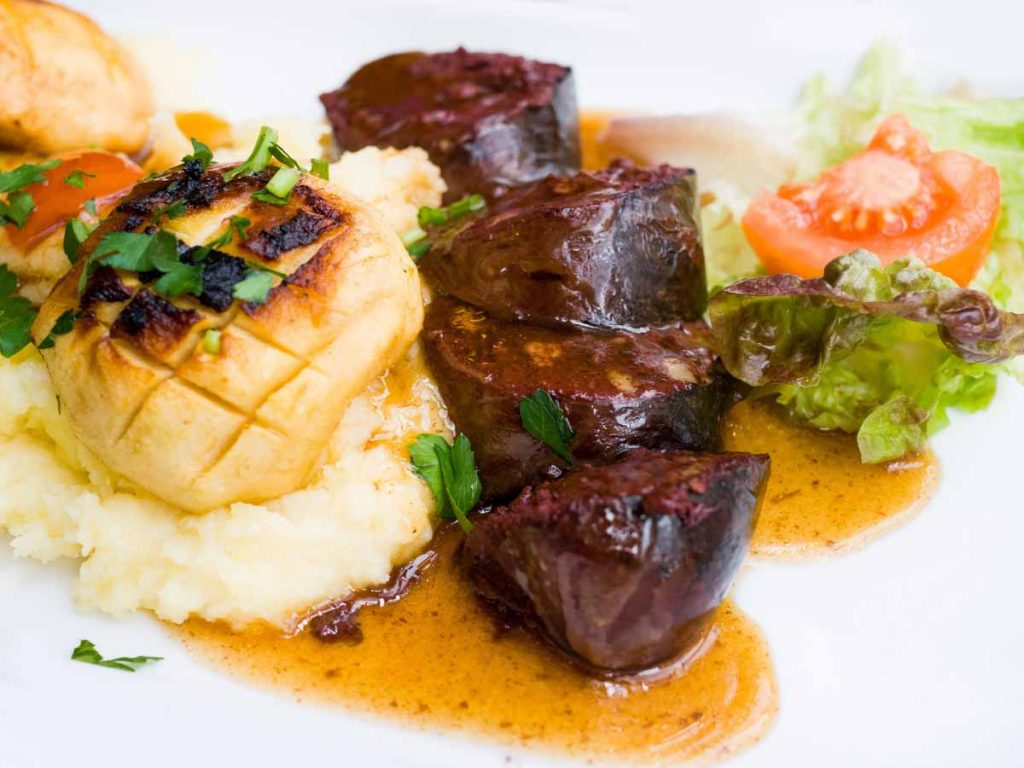French cuisine is famous around the world for its rich flavors and obsession with quality. But there’s another side to it that might surprise you.
Beyond the fresh baguettes, creamy cheeses, and fine wines, there’s a whole world of unusual French foods that locals proudly consider delicacies but many foreigners find strange, or even off-putting at first.

Disclaimer: This post might contain affiliate links. This means we may earn a small commission (at no extra cost to you) should you choose to sign up for a program or make a purchase using one of our links. It’s okay – We love all of the products we recommend anyway, and you will too! Also, that commission helps us keep this awesome free blog up to date! You can read our full disclosure here for more details!
Some might seem a bit extreme, others just unusual, and a few might challenge your comfort zone entirely. But if you’re curious about France’s food culture beyond the classics, here are the weird French foods worth trying at least once.
They might not all win you over, but they’ll definitely give you a deeper look into how adventurous French cuisine can be.
Before You Go, Here’s How to Plan Your Visit To Paris: Practical Quick Tips
WHERE TO STAY
Best Eiffel Tower Views: Hôtel Le Walt (8.9)
Luxury stay: Pullman Paris Tour Eiffel (8.3)
Mid-range stay: Hôtel Eiffel (8.6)
Budget Stay: People – Paris Bercy (8.8)
Apartment Rental: Résidence Charles Floquet (9.2)
BEST GUIDED TOURS
Louvre Museum guided tour: (4.5/5)
Seine River Dinner Cruise: (4.7/5)
Montmartre Walking Tour: (4.8/5)
Le Marais Walking Food Tour: (4.9/5)
Versailles Guided Tour: (4.7/5)
Eiffel Tower Guided Tour: (4.7/5)
Private Transfer from CDG Airport to Paris: (4.7/10)
THINGS TO BOOK BEFORE COMING TO PARIS
Consider getting a Paris museum pass if you plan to visit many attractions. It will save you money, and time, and you’ll skip the line at most sites.
Book this private transfer from CDG airport to Paris to avoid the hustle of figuring out how to get to Paris from the airport.
Considering travel insurance for your trip? World Nomads offers coverage for more than 150 adventure activities as well as emergency medical, lost luggage, trip cancellation, and more.
Weird Food in France
1. Escargots (Snails)

Escargot is one of those dishes that instantly raises eyebrows, especially if you didn’t grow up eating snails. But in France, it’s a classic.
You’ll usually find them served in their shells as a starter at restaurants, covered in a generous mix of garlic, butter, and parsley.
The texture is soft and slightly chewy, and the flavor comes almost entirely from the rich sauce. It’s not something locals eat every day, but it’s a traditional part of French cuisine, especially around Christmas.
The most well-known type is Escargots de Bourgogne (Burgundy snails), often served in sets of six or twelve. Even if you’re unsure about the idea, this is one of those foods that’s worth trying at least once, just to say you did, and who knows, you might actually like it.
2. Bulots (whelk/sea snail)

If you order a traditional French seafood platter, chances are you’ll spot a few of these sea snails alongside oysters, clams, shrimp, and crab.
Known as bulots in French, whelks are a popular appetizer, especially in coastal regions and seafood brasseries.
They’re typically boiled and served cold, often with a side of mayonnaise or a squeeze of lemon.
The flavor is mildly salty with a hint of sweetness, and the texture is firm and slightly chewy, similar to clams but a bit denser. Like most shellfish, they can turn rubbery if overcooked, but when prepared well, they’re surprisingly tasty.
3. Les cuisses de Grenouille (Frog legs)

Aside from escargot, frog legs are another dish that many people immediately associate with France.
Even though they didn’t originate here, they’ve become a well-known part of traditional French cuisine, so much so that you can even find them in some supermarkets. That said, they’re best enjoyed at a reputable restaurant, where the quality is usually higher and the preparation is more refined.
Like escargot, they’re cooked with butter, garlic, and parsley and often served as a starter. The meat is light and tender, with a mild flavor often compared to chicken, though with a slightly fishier taste.
You won’t find them on every menu in Paris, but some classic bistros and regional restaurants still serve them. If you’re curious and open to trying something different, frog legs are one of the more approachable weird French foods to try.
4. Andouillette (chitterling sausage)

Andouillette is one of the boldest dishes in French cuisine, and it’s definitely not for everyone. This traditional sausage is made from pork intestines (sometimes veal, depending on the region), giving it a strong taste and a smell that’s just as intense.
It’s usually pan-seared or grilled, then served with a mustard-based sauce or sometimes a creamier version, depending on where you try it.
You’ll find andouillette on a few menus in Paris, but it’s more closely tied to the cuisine of Lyon, where it’s much more common. It’s definitely not the easiest dish on this list, but if you’re open to trying something truly French, and can get past the smell, this one stands out.
Related post: Fun Facts about French Food
5. Roquefort (Blue cheese)

France is known for its cheese, so it’s only fair to include one on this list, but Roquefort isn’t your average wedge of brie or camembert.
This blue cheese is made from sheep’s milk and aged in natural limestone caves, which is what gives it those striking blue veins and strong, tangy flavor. It’s creamy, crumbly, and full of character, but also pretty intense if you’re not used to these kinds of cheeses.
It also has a pungent smell and the appearance can be a bit off-putting at first, but for cheese lovers, it’s considered one of France’s finest. You’ll find it across the country, but the best Roquefort comes from Southern France, especially near Toulouse, where it’s been made for centuries.
6. Couilles de Mouton (Mutton testicles)
This one definitely ranks high on the list of strange French dishes. Couilles de mouton, or mutton testicles, might not sound appealing to most, but they’ve been part of regional cuisine for generations, especially in the Périgord region, where it’s a specialty and commonly known as frivolités bénéventines.
It’s not something you’ll easily find on restaurant menus across France, so if you’re curious, the best place to try it is in Périgord itself.
The preparation is surprisingly simple. The testicles are cleaned, soaked in cold water for a few hours, then diced and grilled with lemon, parsley, and sometimes a touch of white wine or cream. The flavor is mild and the texture is soft, making it more approachable than you might expect if you can get past the idea of what it is.
7. Foie gras (Goose’s fatty liver)

Foie gras is one of the most famous and controversial dishes in French cuisine. Made from the liver of a duck or goose that has been fattened through a process known as gavage (force-feeding), it’s prized for its rich, buttery texture and delicate flavor. You’ll often see it served as a pâté, a mousse, or simply sliced and pan-seared as a starter.
Despite its status as a French delicacy, foie gras has sparked a lot of debate in recent years. Animal welfare concerns around the force-feeding process have led to growing pressure, both within and outside of France, to end its production. Some cities and regions have already placed restrictions on it, and there have been discussions at the national level about banning it altogether.
Still, foie gras remains a holiday staple in many French households, especially around Christmas and New Year.
8. Pieds de porc (Pigs’ feet)

The French are known for using every part of the animal, so seeing pigs’ feet on the menu shouldn’t come as a surprise. While it’s not the first dish that comes to mind when you think of French cuisine, it’s been part of traditional cooking here for generations.
The feet are typically simmered for hours until the meat is tender and the skin soft and gelatinous. The texture can be a bit much for some, but the flavor is rich and savory.
Depending on the recipe, they might be served as-is with a bit of mustard or baked for a crispier finish.
9. Langue de boeuf (Beef tongue)

Just like pieds de porc, langue de bœuf can be prepared in a variety of ways. The tongue is usually boiled, salted, and sliced into thin strips, then either served with vegetables, braised in Madère sauce, or roasted.
While it may sound like an unusual dish, the texture is soft and tender like any other meat dish, and if you didn’t know it was tongue, you might not even realize you’re eating anything out of the ordinary.
10. Ris de veau (Calf’s pancreas/ Sweetbreat)

This might sound like one of the strangest dishes on a French menu, but ris de veau, the pancreas of a calf (or lamb occasionally), is actually considered a delicacy in traditional French cuisine.
Often referred to as sweetbread (despite not being sweet nor made of bread), it has a mild flavor and a creamy texture that sets it apart from most cuts of meat.
Before cooking, the sweetbread is soaked, blanched, and trimmed, then typically pan-seared until golden on the outside and soft inside.
It’s often served with a rich sauce and sometimes paired with mushrooms or seasonal vegetables. You won’t see it everywhere, but it still appears in classic French restaurants and on special occasion menus.
11. Tête de Veau (Calf’s head)

Another part of the calf used in French cuisine is the head. It is popularly served in Sauce gribiche, a mix of hard-boiled eggs, mustard, pickles, herbs, and a light oil like canola or rapeseed oil.
In some versions, the head is deboned, tied with string, and brought to the table whole. If seeing that is something you can digest (pun intended), go for it. But if you’re new to this kind of dish, the sliced version with sauce gribiche is probably the better place to start.
Fun fact: it was one of former French president Jacques Chirac’s favorite dishes.
12. Les Tripes or Tripes (Veal stomach)

If you can stomach this next weird French dish, you might just be a little bit French already! Made from the stomach lining of a calf, tripes are especially popular in the northern and western parts of the country, where they’re often slow-cooked with onions, carrots, white wine, and herbs to bring out their full flavor.
The texture is soft with a bit of chew, and while it’s not the easiest dish to love right away, many locals see it as classic comfort food.
You’ll mostly find it in countryside restaurants or at bistros that specialize in regional foods.
13. Boudin Noir (Black pudding/blood sausage)

Boudin noir is a traditional French blood sausage made from pig’s blood, onions, and fat. It’s usually pan-fried and served with mashed potatoes, stewed apples, or caramelized onions to balance out its intense flavor.
While it might seem intimidating at first, it’s still enjoyed across France, especially in home-style cooking and traditional butcher shops. If you’re open to trying something a little outside the usual, this one is worth tasting.
Fun fact: Many countries in Europe have their own version of boudin noir, from Germany’s blutwurst and Poland’s kaszanka to Croatia’s krvavica and Estonia’s verivorst, which is even considered a national dish.
14. Steak tartare (Raw Minced Beef)

Steak tartare is one of those French dishes that tends to divide opinions. It’s made with raw minced beef, typically seasoned with salt, pepper, capers, onions, and mustard. Just before serving, it’s often topped with a raw egg yolk.
You’ll usually find it served with fries and a simple green salad, and in most restaurants, it’s prepared à la minute, meaning freshly mixed when you order.
While the idea of eating raw meat might not appeal to everyone, steak tartare is generally considered safe to eat. It’s one of those dishes you’ll find on nearly every Parisian brasserie/bistro menu.
15. Cerveaux ( Lamb Or Veal’s Brains)
Cerveaux refers to animal brains, most commonly from veal or lamb, and while it’s not something you’ll see on everyday menus, it’s still part of France’s traditional cuisine. The texture is soft and creamy, and the flavor is mild, which might surprise anyone expecting something more intense.
The brains are usually soaked, then either poached or lightly pan-fried, and sometimes served with lemon, herbs, or a light butter sauce to help preserve their delicate texture and subtle taste without being overpowered by heavy seasoning.
You won’t find this dish just anywhere in Paris, but it occasionally appears in older bistros or during special regional menus.
16. Oursins (Sea urchins)

Oursins are sea urchins, a delicacy along the French coast, especially in the south. What you eat is the bright orange roe inside, often described as briny, slightly sweet, and creamy in texture.
They’re usually eaten raw, sometimes straight from the shell with just a squeeze of lemon. In some coastal towns, they’re also served on seafood platters or lightly mixed into pasta or scrambled eggs.
Because they’re seasonal and highly perishable, Oursins aren’t something you’ll find everywhere, and they’re rarely served in Paris.
But if you’re traveling near the Mediterranean coast between December and March (the peak sea urchin season) and you’re open to something new, this is one of the more unique French foods to try.
17. Farci Poitevin
Last on this list of weird food from France is Farci Poitevin, a traditional dish from western France, especially the Poitou-Charentes region. It’s a type of vegetable pate made by blending leafy greens, cabbage, leeks, and herbs into a compact, sliceable loaf.
The mixture is wrapped in cabbage leaves, tied, and slowly cooked, either steamed, boiled, or baked until firm. Once it cools, it’s sliced and served cold, often as a starter.
Final Thoughts on the Weird French Foods
France may be known for its cheese, wine, and pastries, but there’s so much more to discover once you look beyond the classics.
From sea urchins and frog legs to dishes made with brains, intestines, or even blood, these weird French foods offer a deeper look into the country’s culinary traditions, some dating back centuries.
Not every dish will be to everyone’s taste, and that’s okay. But if you’re open to exploring what locals have been cooking and enjoying for generations, trying even one of these unusual French specialties can add a completely new layer to your experience in France.
So whether you’re curious, brave, or just hungry for something different, don’t be afraid to step out of your comfort zone. You might just find a new favorite in the most unexpected place on the menu.
NEVER TRAVEL TO PARIS WITHOUT TRAVEL INSURANCE
One of the biggest mistakes you’ll ever make when planning a trip to Paris is to forego Travel Insurance!
You might think that it’s expensive, but when you think of how much it will save you when you lose your valuables or even get sick, then you’ll know that it’s NOT that expensive!
Unfortunately, things can and do go wrong when you travel. World Nomads offers coverage for
more than 150 activities as well as emergency medical, lost luggage, trip cancellation, and more. If you’re considering travel insurance for your trip, check out World Nomads.
Check out these posts to help you plan your trip to Paris
- Nontouristy things to do in Paris
- Stunning views from the Eiffel Tower
- How to plan a perfect picnic in Paris
- Big mistakes to avoid while traveling in Paris
- Things to know before traveling to Paris
- Best Hotels in Paris with Eiffel Tower views
- Things to do in Paris at night
- How to skip the long lines in Paris
- Best places to get stunning views of the Eiffel Tower
Was this post on the weird French foods to try helpful? Then please consider sharing it with others.







